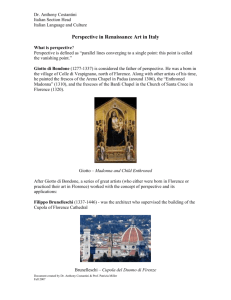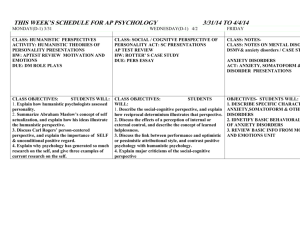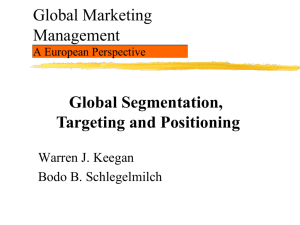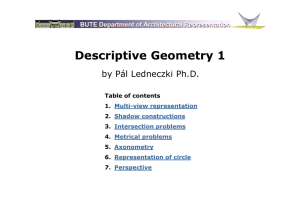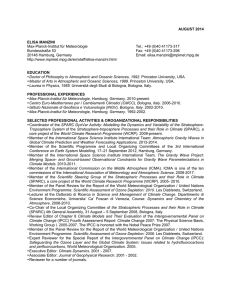More perspective - Perryville School District
advertisement
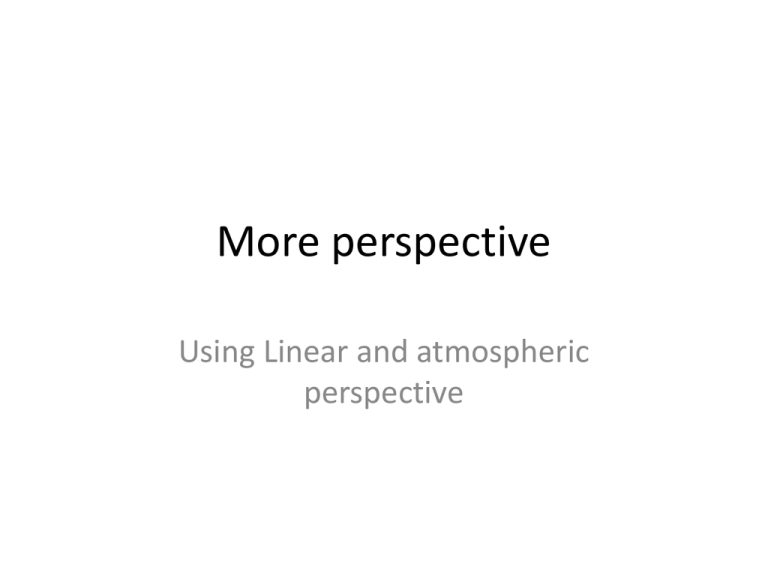
More perspective Using Linear and atmospheric perspective Perspective – the illusion that an image has depth and 3dimensional space (volume) VERTICAL PLACEMENT & OVERLAPPING INTERPRETED AS 3 RECTANGLES RELATIVE SIZE SASSETTA The Meeting of St. Anthony and St. Paul about 1440 Wood NO PERSPECTIVE Perspective was a concept that had to be developed. Cimabue, Madonna Enthroned, 1280-90 Now we see perspective, and it looks real… with the exception of the “adult/baby” There were suggestions of perspective in a Gothic era work. However, perspective is a major development of the Renaissance. GIOTTO Madonna in Glory c. 1311 Tempera on panel 128 x 90 1/2 in. Judging by the Eye Giotto introduced a new kind of realism by creating convincing spatial arrangements. He angled the building, removing side walls to reveal the cubic interior. Giotto. Birth of the Virgin Mary (1320s). Fresco. When using atmospheric perspective… • hues more bluish & more pale • outlines less precise • small details lost • color contrasts muted • gradual transition Atmospheric Perspective, rewind! Objects CLOSER Objects FARTHER • Appear lower on the page • Overlap- In front of • Are larger • Brighter colors • Darker value • More contrasts • More Details • Appear higher on the page • Overlap-behind • Are smaller • Duller colors • Lighter value • Faint/fuzzy lines • Very few or not details LINEAR PERSPECTIVE Vanishing point One point; central What is Linear Perspective? A system for representing three-dimensional space on a two-dimensional flat surface. • It was developed in Florence in the early 15th century by Filippo Brunelleschi and Leon Batista Alberti Application of Linear Perspective Brunelleschi's proposal drawing of the interior of Santo Spirito (1543) Interior of Brunelleschi's Santo Spirito Normal Viewpoint High Viewpoint Low Viewpoint Use lines to show the illusion of depth. Receding lines (going back into space) meet at the vanishing point The vertical and horizontal lines are parallel to the edge of the paper The Vanishing Point does not have to be right in the Center of the Paper 1-point Linear Perspective: parallel lines appearing to converge in distance 1-point Linear Perspective: parallel lines appearing to converge in distance Click here to activate orthogonals: Review orthogonals: Leonardo da Vinci’s Explorations The Last Supper (1497). Fresco. Leonardo da Vinci, Last Supper, c.1495-98 Milan, Sta. Maria della Grazie Raphael, The School of Athens, 1510-11 Vatican Palace, Stanza della Segnatura Raphael, The School of Athens, 1510-11 Vatican Palace, Stanza della Segnatura Atmospheric Perspective (in addition to 1 - pt. Perspective) Perugino, Christ Delivering the Keys to St. Peter, c.1481 Sistine Chapel, Vatican Atmospheric Perspective (in addition to 1 - pt. Perspective) Perugino, Christ Delivering the Keys to St. Peter, c.1481 Sistine Chapel, Vatican Canaletto (Giovanni Antonio Canal), The Campo di Rialto c. 1758-63 Oil on canvas, 46 7/16 x 72 1/2 in Canaletto (Giovanni Antonio Canal), The Campo di Rialto c. 1758-63 Oil on canvas, 46 7/16 x 72 1/2 in The vanishing point comes from below? The vanishing point and perspective is constructed according to the upward gaze of an observer standing directly below. Andrea Mantegna. From The Painted Room (1465-74). Fresco. With practice you can create any of the things you have just seen. We will start out easy…

